Review: Zelda Skyward Sword
The legend of Zelda: Skyward Sword
Release Date: November 20, 2011
Developer: Nintendo
Publisher: Nintendo
Genre: Action / Adventure
Plataform: Nintendo Wii
To criticize about a game so strong and expected as the Zelda series, requires a lot of responsibility on the part of the writer. Of course, anyone can pick up a paper – or in this case a blog! – And write whatever they want, without using foundation or even trying to prove and to invent new reasons to justify his criticism. This does not mean that an analysis is worth more than the other, but what should be taken into account is the responsibility brought along with his words. And it is thinking about this aspect that I start my review on the newest game in the series The Legend of Zelda. This time the long-awaited Skyward Sword. I believe that many may not agree with my opinion here, perhaps taking it personally and not accepting that one can negatively criticize this game in some aspects, but I hope you understand that analyzed not only the side of art, as well as technical aspects.
A friendship in the sky
A letter of Zelda comes to Link early in the game. Unlike expected, is not a distress call from the young princess, but a warning reminding you of the event between both of them. In this new adventure, Link, Zelda and the other characters do not live in the famous land of Hyrule. His new place is called Skyloft, an island that floats above the clouds in the sky. And as a floating city, the whole aspect of art, gadgets and buildings are based upon this concept. The main transport of people are already trained giant birds known as Loftwings. And, of course, the bird of Link is different from the others, causing him to suffer prejudice on the part of the town troublemakers, and compliments on the part of Zelda, her best friend from childhood and, until then, it is not a princess.
It is interesting to note that the timeline between this, with previous games in the series, follows a disordered flow. By the way history is presented, makes you believe that Skyward Sword takes place before the events of Ocarina of Time. No one can say that all games follow a sequence and complete in itself, but somehow if we were put in a timeline, that would be what makes the most sense so far, taking into account that the inhabitants of Skyloft not know the “world below the clouds”, and that fear was like hell down there and was just a legend. But of course that is not enough to Zelda. She believes that there is a whole new world down there, and that even the other calling that place of legend, she was always curious to discover and prove their veracity.
Dialogues here, childish taunts there and some disputes in the sky – which is also one of the coolest thing in the game! – While Zelda and Link are talking and flying over their giant birds, a strong whirlwind comes and sucks the girl down there. So Link must leave for his childhood friend and uncover the secrets of the world below the clouds, finally discovering the evil land of Hyrule. To do this, Link meets Fi, a spirit of feminine appearance, created by the Goddess worshiped in Skyloft, which inhabits the sword of Link. She will guide Link on his journey, providing information necessary for its advancement, helping at certain times of the plot.
It is noteworthy that unlike The Wind Waker, which we sailed in a boat, fly in your Loftwing in Skyward Sword can be an amazing experience. To begin the flight speed does not compare to the time it took the boat to cross the oceans. Flying is something magnificent, practical and fun. All control of Link’s Loftwing is made with the movements of the Wii Remote. And the feeling of weightlessness for the variation of speed is something that really responds very well. Not to mention how fun it is to run out of the floating island and jump in the clouds, calling your bird with a whistle and flying freely in the sky.
When the Legend evolved
Create a new game for an old franchise requires a lot of the developers, especially when it is considered a legend. What is better? Risk and develop points that have always been well-regarded in the series, but trying to innovate with what is already offered for the new generation, or keep the same rate as the previous games and be sure it will be a good game, but without any great new? Luckily Skyward Sword tries to mix a little of both and can evolve, but without slipping and risking too much. The present developments in the game are rather details that bring a more positive aspect, but it’s nothing that really stands out as a great new differential, which finally could have been.
I would rate this new Zelda as an Action / Adventure game with new RPG touches. I say RPG because now this is an evolving system of items and equipment that are based on the collection of other specific materials during the game, such as jewelry, captured insects etc. You have the freedom to evolve what equipment you want and even to have a stronger shield you should evolve it or use one that best suits in the environment you are visiting then, remembering that now shields can break depending on usage unbalanced. Again, I sort as an RPG game because even the narrative of the game in the end of everything just follow the same line, the way everything is presented and the fact that Link remains a “dumb” character, makes this game even more closely matches in the genre. This inclusive, are details that should have been better observed by the creative team. First, why to offer the player a choice of answers that Link could give during the game, if all the answers will lead to exactly the same result, only changing the tone of the conversation? Or, before all the fantastic art direction and soundtrack of the game, why not this time progress and not risk a little more and dub the voices of the characters eventually? Even if that dubbing follow a dialect unique and special, as the character Fi in the game features. Well, these are questions that will be left unanswered for now…
Still treating of the technical side I must confess an initial shock that I had when I play the game in Nintendo Wii. Unconsciously, it comes to the current generation of Video Games, we are frightened when we see graphics that do not correspond with those of recent games. My first impression to start playing Skyward Sword was that something was wrong with my television. The graphics did not look beautiful, the textures are presented in low resolution and jaggies, wow, how many jaggies! But I can guarantee that after 20 minutes your whole outlook changes and the game begins to convince you perfectly, because you see a great affection in every little detail of the scenarios, colors, art direction, great level design and creativity with everything. The game features a color palette to envy others. Combining this with superb soundtrack managed by Koji Kondo, we can’t criticize the game and not drooling for each new second. In my opinion, is definitely the best soundtrack of the game series The Legend of Zelda.
As we are talking about technical developments, another major difference is the new gameplay that the game presents. Attacking using Link’s sword is now much more fun. Finally, with the help of the Motion Plus, the game has more accurate controls – as far as possible! – Ensuring that the movement of the sword will follow the same direction and angle that you do holding your Wii Remote with your hands. The feeling of lifting your Wii Remote over your head and see Link doing the same movement while charging the energy of the sword is amazing. Cuts are allowed horizontal, vertical and diagonal from left to right or vice versa, while the Nunchuck is responsible for the control of the shield on the other hand. And the coolest part of all this is that “with great power, comes great responsibility” and, therefore, the enemies have different strategies to combat them, which vary for the position that they defends or attacks. In fact, in the case of a difficulty curve, I found that the Skyward Sword has the greater initial difficulty in Zelda games series. I emphasize the word “initial” because although the game begins with a difficulty curve strengthened, everything ceases to exist going forward. Despite going Dungeons becoming increasingly complex, lengthy and at times even boring, the bosses in the end of each Dungeon possess a decreasing level of difficulty, which is unsatisfactory.
The Goddess Oracle
During the search for Zelda in the World below the Clouds, Link comes across another character that is also behind the girl, in which he refers to as the Oracle of the Goddess. The character, known as Lord Ghirahim, is the villain of the game and aims to resurrect their master, and for that, somehow need Zelda.
Lord Ghirahim can be one of the MOST BIZARRE villains of all time. Possessing feminine traits, haircut “trendy” and clothes that seem to have gone out of the closet of Lady Gaga leave it even stranger. The objectives of the villain are not fully disclosed at the beginning of the game. All we know is that Zelda is one of the chosen and possess a very vital role for both the Goddess and to generate enough energy to revive the great master of Ghirahim. So besides having to go in search for Zelda and understand everything that is happening, Link must also be present in time to protect the girl from the surprise attacks of Lord Ghirahim.
One of the sacred objects in Skyward Sword and that inclusive is Zelda that handling early in the game, is the Harp of the Goddess. It would be the equivalent of Ocarina in Ocarina of Time. During the game you also learn to play different songs on the harp, and the entire command is controlled by the Motion Plus, simulating the motion of strumming.
The Hero’s Journey
Throughout all his journey and his goal of save her best friend Zelda in the World below the Clouds, Link begins to realize that there are more secrets than he could imagine. He realize that Zelda also has a mission and it will not give it up until she finish her goal, regardless of the new danger that she is running. New alliances are emerging, proving that Link is not alone in this. But to achieve your next step, the energy of the Triforce is put into practice again, forcing our hero to find within you the Strength, Courage and Wisdom enough to be able to complete this additional challenge.
While I analyze in a positive point the way that Triforce is presented in Skyward Sword, showing that Link must earn that power to move on, there is another point that disappointed me a little and added a lot of negative way for the progress of history, which is the repetition.
Okay, this new Zelda is probably the largest Zelda Game ever launched before. The total time of the game is huge if you complete all the goals and extra check for all items, and even then only if the linear narrative of the game duration is also very rewarding. However, there are several completely unnecessary moments or ways that developers justified to extend the plot. If you are one of the players that, for example, didn’t like the forced repetition of the game Folklore (PS3) in return for their game scenarios, you end up feeling uncomfortable about it around here too.
After completing the initial and main Dungeons in the game to finally get to earn and acquire the power of the Triforce, Link must travel again for each of the Dungeons and achieve what is asked in the game. Of course, the scenarios change in some respects, but nothing like it so much that the players need to “recycle” level designs that at first impression, was seen in a good way. The obligation to follow the same steps again, give to Skyward Sword a downside to the game.
Still, even with some technical problems, repetitions or even that feeling that could have been a game more evolved compared to previous series, The Legend of Zelda: Skyward Sword can stand well with an impeccable art direction, a level design to let anyone open mouth, and keeps on top, or rather, above the clouds, proving once again that the LEGEND remains as a Legend.
My Personal Score: 3,5/5
– Matheus Pitillo
acompanhe esse texto em português
Fazer uma crítica a respeito de um jogo tão forte e ansiado como da série Zelda, requer muita responsabilidade da parte do redator. É claro que qualquer pessoa pode pegar um papel – ou no caso um Blog! – e escrever o que bem entender, sem usar fundamentos ou até mesmo tentando provar e inventar novos fundamentos que justifique suas críticas. Isso não quer dizer que uma análise vale mais do que a outra, mas o que deve ser levado em conta é a responsabilidade trazida junto com suas palavras. E é pensando nesse aspecto que começo meu review sobre o mais novo jogo da série The Legend of Zelda. Dessa vez o tão esperado Skyward Sword. Acredito que muitos talvez não concordarão com a minha opinião por aqui, talvez levando para o lado pessoal e não aceitando que alguém possa criticar negativamente esse jogo em alguns aspectos, mas espero que entendam que analisei não só o lado da arte, como também aspectos técnicos.
Uma amizade nas alturas
Uma carta de Zelda chega para Link logo no começo do jogo. Diferente do esperado, não é um pedido de socorro da jovem princesa e sim uma alerta lembrando-o do combinado entre os dois. Nessa nova aventura, Link, Zelda e os outros personagens não vivem na famosa terra deHyrule. Seu novo lugar se chama Skyloft, uma ilha que flutua acima das nuvens, no céu. E como uma cidade flutuante, todo o aspecto de arte, engenhocas e construções se baseiam em cima desse conceito. O transporte principal dos já treinados habitantes são pássaros gigantes conhecidos como Loftwings. E, claro, o pássaro de Link é diferente dos demais, fazendo com que ele sofra preconceito da parte dos encrenqueiros da cidade, e elogios da parte de Zelda, sua melhor amiga desde crianças e, que até então, não é uma princesa.
É interessante levar em conta que a linha de tempo entre este, com os jogos anteriores da série, segue um fluxo desordenado. Pela maneira que a história é apresentada, faz acreditar que Skyward Sword se passa antes dos acontecimentos de Ocarina of Time. Não que podemos afirmar que todos os jogos seguem uma sequência e se completam em si, mas de certa forma se fossemos colocar em uma linha de tempo, isso seria o que faz mais sentido até então, levando em conta que os habitantes de Skyloft não conhecem o “Mundo abaixo das nuvens“, e que o temem como se lá embaixo fosse o inferno e não passasse de uma lenda. Mas claro que para Zelda isso não é o suficiente. Ela acredita que existe todo um novo universo lá embaixo, e que mesmo os outros chamando aquele lugar de lenda, ela sempre teve curiosidade de desvendar e provar a sua veracidade.
Diálogos de cá, provocações infantis de lá e algumas disputas pelo céu – que inclusive é uma das coisas mais legais do jogo! – enquanto Zelda e Link estão conversando e voando em cima das suas aves gigantes, um forte redemoinho surge e suga a garota lá para baixo. Sendo assim, Link precisa partir para uma jornada atrás de sua amiga de infância e desvendar os segredos do Mundo abaixo das nuvens, finalmente descobrindo a terra maligna de Hyrule. Para isso, Link conhece Fi, um espírito de aparência feminina, criado pela Deusa cultuada em Skyloft, que habita a espada de Link. Ela guiará Link em sua jornada, fornecendo informações necessárias para seu avanço, ajudando em certos momentos da trama.
Vale ressaltar que ao contrário de The Wind Waker, que navegávamos em um barquinho, voar em seu Loftwing em Skyward Sword consegue ser uma experiência sensacional. Pra começar a velocidade do vôo nem se compara ao tempo que o barquinho levava para cruzar os oceanos. Voar é algo magnífico, prático e divertido. Todo o controle do Loftwing de Link é feito com os movimentos do Wii Remote. E a sensação de leveza, para a variação de velocidade, é algo que realmente responde muito bem. Sem contar o quão divertido é correr para fora da ilha flutuante e se jogar nas nuvens, chamando seu pássaro com um assobio e podendo voar livremente pelo céu.
Quando a Lenda evoluí
Criar um novo jogo para uma antiga franquia exige muito dos desenvolvedores, principalmente quando a mesma é considerada uma lenda. O que vale mais? Arriscar e evoluir pontos que sempre foram bem vistos da série, mas tentando inovar com o que já é oferecido para a nova geração, ou manter no mesmo ritmo dos jogos anteriores e ter a certeza de que será mais um bom jogo, mas sem nenhuma grande novidade? Por sorte Skyward Sword tenta misturar um pouco das duas coisas e consegue evoluir, mas sem deslizar e arriscar demais. As evoluções presentes no game são sim detalhes que trazem um aspecto positivo a mais, mas também não é nada que realmente chame a atenção como um grande novo diferencial, como finalmente poderia ter sido.
Eu classificaria esse novo Zelda como um Action / Adventure com novos toques de RPG. Digo RPG porque agora está presente um sistema de evolução de itens e equipamentos que se baseiam na coleta de outros materiais específicos durante o jogo, como joias, insetos capturados etc. Você tem a liberdade de evoluir quais equipamentos você deseja e, inclusive, para ter um escudo mais forte você deve evoluí-lo ou usar o que melhor atende ao ambiente que você for visitar em seguida, lembrando que agora os escudos podem quebrar dependendo do uso desequilibrado. Novamente, classifico como RPG porque apesar da narrativa do jogo no final de tudo seguir uma mesma linha apenas, a maneira que tudo é apresentado e o fato de o Link continuar sendo um personagem “mudo”, faz com que esse jogo se aproxime mais ainda do gênero. Isso, inclusive, são detalhes que acho que deveriam ter sido melhor observados pela equipe de criação. Primeiro, pra que oferecer ao jogador algumas opções de respostas que Link poderia dar durante o jogo, se todas as respostas vão levar exatamente para o mesmo resultado, mudando apenas o tom da conversa? Ou ainda, diante de toda a fantástica direção de arte e trilha sonora do jogo, porque dessa vez não evoluir e arriscar um pouquinho mais e não dublar as vozes dos personagens finalmente? Nem que essa dublagem seguisse um dialeto único e especial, como a própria personagem Fi possui no jogo. Bom, isso são perguntas que vão ficar sem respostas por enquanto…
Ainda se tratando da parte técnica preciso confessar um susto inicial que eu tive assim que liguei o Nintendo Wii. Inconscientemente, se tratando da atual geração de Vídeo Games, nós nos assustamos quando vemos gráficos que não se equivalem aos dos jogos recentes. A minha primeira impressão ao começar a jogar Skyward Sword foi de que alguma coisa estava errada com a minha televisão. Os gráficos não pareciam bonitos, as texturas se apresentavam em baixa resolução e os serrilhados, nossa, quantos serrilhados! Mas posso garantir que passados 20 minutos toda a sua visão do jogo se altera e começa a te convencer perfeitamente, porque você percebe um carinho muito grande em cada mínimo detalhe dos cenários, das cores, da direção de arte, level design e da enorme criatividade com tudo. O jogo possuí uma paleta de cores de dar inveja aos demais. Somando isso a soberba trilha sonora gerenciada por Koji Kondo, não conseguimos criticar o jogo e não babar há cada novo segundo. Na minha opinião, com certeza é a melhor trilha sonora dos jogos da série The Legend of Zelda.
Como estamos falando sobre evoluções técnicas, outro grande diferencial é a nova jogabilidade que o game apresenta. Atacar utilizando a espada de Link agora é bem mais divertido. Finalmente, com a ajuda do Motion Plus, o jogo possui controles mais precisos – na medida do possível! – que garante que o movimento da espada seguirá a mesma direção e ângulo que você fizer segurando o seu Wii Remote com as mãos. A sensação de erguer o Wii Remote acima de sua cabeça e ver Link fazendo o mesmo movimento enquanto carrega a energia da espada é incrível. São permitidos cortes horizontais, verticais e diagonais, da esquerda para a direita ou vice-versa, enquanto o Nunchuck é o responsável para o controle do escudo na outra mão. E parte mais legal de tudo isso é que “com grandes poderes, vêm grandes responsabilidades” e, sendo assim, os inimigos possuem estratégias diferentes para combatê-los, que variam pela posição que o mesmo se defende ou ataca. Aliás, se tratando de uma curva de dificuldade, eu achei Skyward Sword o que possui uma maior dificuldade inicialda série Zelda. Destaco a palavra “inicial”, porque apesar do jogo começar com uma curva de dificuldade reforçada, tudo deixa de existir mais para frente. Apesar das Dungeons irem ficando cada vez mais complexas, longas e em alguns momentos até chatas, os chefões ao fim de cada Dungeon possuí um nível de dificuldade decrescente, o que deixa a desejar.
A Oráculo da Deusa
Durante a busca por Zelda no Mundo abaixo das Nuvens, Link se depara com um outro personagem que também está atrás da garota, na qual ele se refere como a Oráculo da Deusa. O tal personagem, conhecido como Lord Ghirahim, é o vilão do game e almeja ressuscitar seu mestre e, para isso, de alguma forma precisa de Zelda.
Lord Ghirahim consegue ser um dos vilões MAIS BIZARROS de todos os tempos. Possuí traços femininos, corte de cabelo “moderninho” e roupas que parecem ter saído do armário da Lady Gaga deixam ele ainda mais estranho. Os objetivos do vilão não são totalmente revelados no início do jogo. Tudo que sabemos é que Zelda é uma das escolhidas e que possuí uma função muito vital tanto para a Deusa, quanto para gerar uma energia o suficiente para ressuscitar o grande mestre de Ghirahim. Dessa forma além de Link precisar ir em busca de Zelda e entender tudo que está acontecendo, ele também precisa estar sempre presente a tempo para proteger a garota dos ataques surpresas de Lord Ghirahim.
Um dos objetos sagrados de Skyward Sword e que inclusive é Zelda quem manuseia no começo do jogo, é a Harpa da Deusa. Ela seria o equivalente a Ocarina, em Ocarina of Time. Durante o jogo você também aprende a tocar músicas diferentes na Harpa, e todo o comando é controlado através do Motion Plus, simulando o movimento de dedilhar.
A jornada do Herói
Durante toda sua jornada e seu objetivo de salvar sua melhor amiga Zelda no Mundo abaixo das nuvens, Link começa a perceber que existem mais segredos do que ele poderia imaginar. Percebe que Zelda também possui uma missão e que não irá desistir dela até concluir o seu objetivo, independente do novo perigo que ela está correndo. Novas alianças passam a surgir, provando que Link não está sozinho nessa. Mas para alcançar o seu novo passo, a energia do Triforce é posta em prática novamente, forçando o nosso herói a encontrar dentro de você a Força, Coragem e Sabedoria o suficiente para conseguir concluir mais esse desafio.
Enquanto analiso como um ponto positivo a maneira que o Triforce é apresentado em Skyward Sword, mostrando que Link precisa merecer esse poder para seguir em frente, existe um outro ponto que me decepcionou um pouco e somou muito de maneira negativa para o andamento da história, que é a repetição.
Tudo bem, esse novo Zelda provavelmente é o maior já lançado até então. O tempo total do jogo é enorme se você completar todos os objetivos extras e buscar por todos os itens e, mesmo se seguir apenas a narrativa linear do jogo o tempo de duração também é bem gratificante. Porém, existem vários momentos totalmente desnecessários ou maneiras que os desenvolvedores justificaram para alongar a trama. Se você é um dos jogadores que, por exemplo, não gostaram da repetição forçada do game Folklore (PS3) no retorno para seus cenários, você acabará se sentindo incomodado com isso por aqui também.
Após completar as Dungeons principais e iniciais do jogo, para finalmente conseguir merecer e adquirir o poder da Triforce, Link precisa viajar novamente por cada um dos Dungeons e conquistar o que lhe é pedido no game. Claro que os cenários se alteram em alguns aspectos, mas nada que agrade tanto assim os jogadores em precisar “reciclar” level designs que, em primeira impressão, foi visto de boa maneira. A obrigatoriedade de seguir os mesmos passos mais uma vez trás um ponto negativo ao jogo.
Ainda assim, mesmo com alguns problemas técnicos, repetições ou até mesmo aquela sensaçãozinho de que poderia ter sido um jogo ainda mais evoluído em relação aos anteriores da série, The Legend of Zelda: Skyward Sword consegue se sustentar bem com uma direção de arte impecável, level design de deixar qualquer um de boca aberta e se mantem no topo, ou melhor dizendo, acima das nuvens, provando que mais uma vez a LENDA permanece-se como uma Lenda.
Minha nota pessoal: 3,5/5
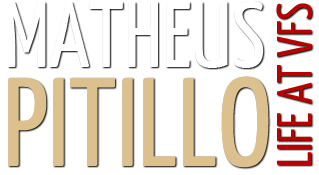
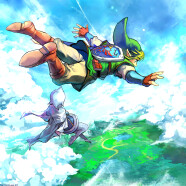





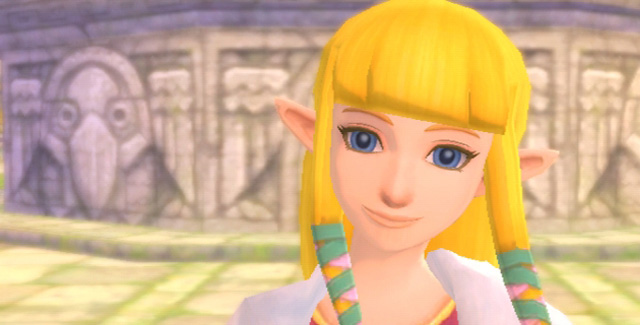
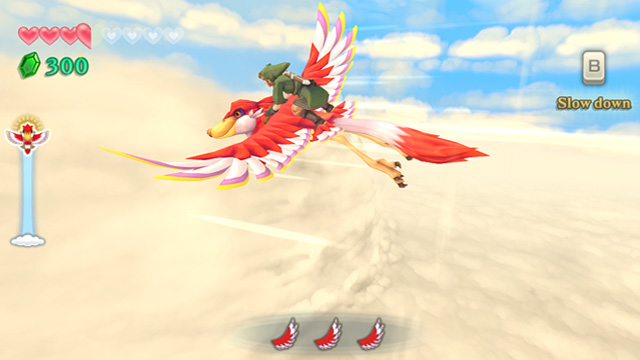
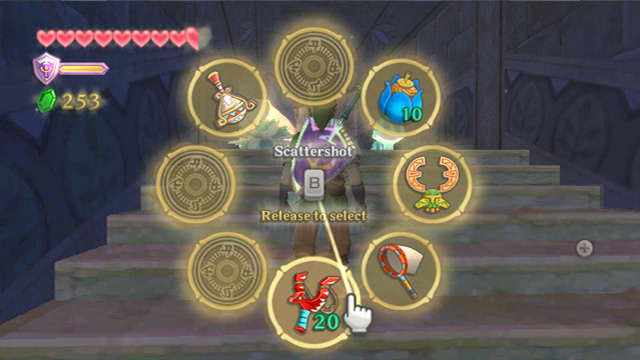
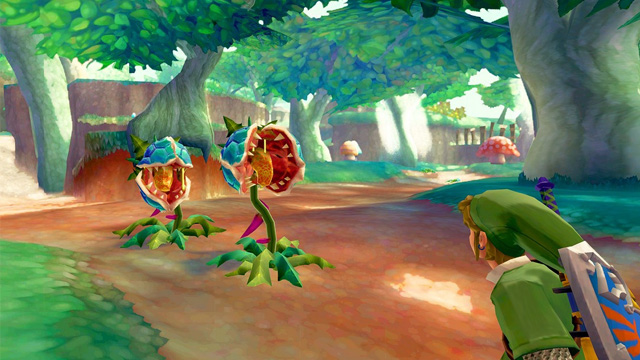
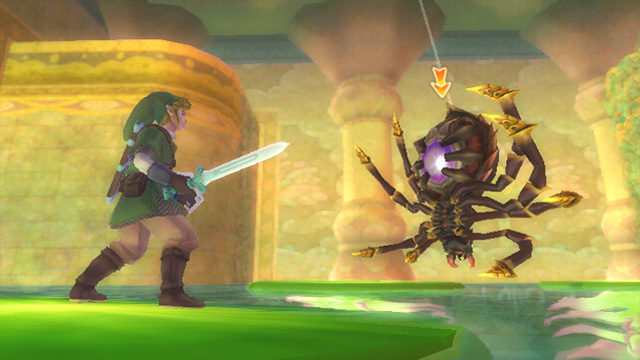
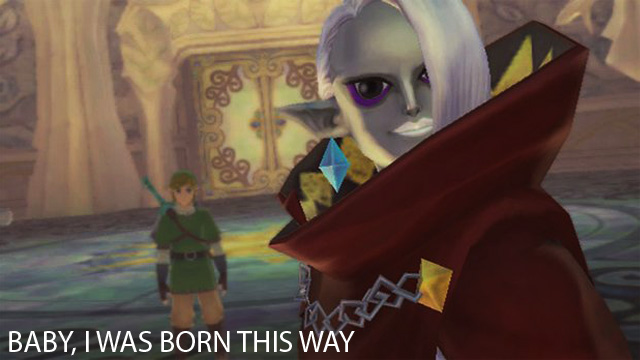

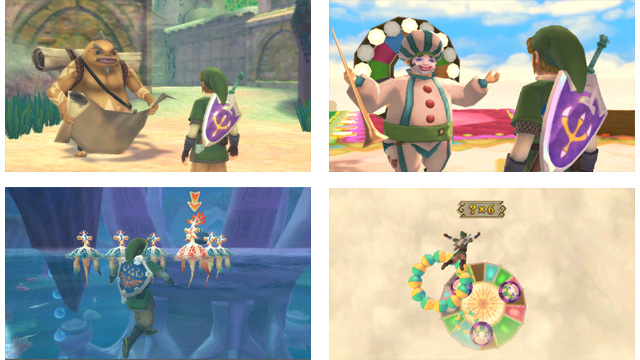
Excelente análise e visão crítica. Eu não posso concordar ou descordar, pois ainda não joguei. Mas pretendo jogar em breve, e com certeza vou me lembrar da Lady Gaga. HAHAHA Amo vc!
Hehehhe estive presente enquanto ele jogava e analizava…realmente o gráfico é show, dá uns sustos as vezes com os morceguinhos de fogo…e é super lady gaga esse personagem..kkk
Dude.. just …great
very well done..!!! Now, I just need to play and see if you are right about it. :)….
Keep going man !!
Muy buen resumen, bastante claro y coherente. Es dificil sacar un juego q compita contra el mismo por su legado que ha dejado.
I just LOVED the art direction of this game! It’s so softly and beautiful, just like a world painted in a great 3D canvas. Awesome!
But i need to say one thing, and i think it’s a common thought. When i saw a float mountain and a giant bird that you ride I immediatly thought in Avatar. I’m not saying it’s a copy, but…well… it’s not so original. =(
Anyway I think the game should be very fun to play. I loved “Ocarina of time” and “A Link to the past” but I’m not here for nintendo’s games anymore. They’re a little overrated for me…The people often love then just because it’s a Zelda or a Nintendo’s game. And I’m not here for that!
But it was a great post! The best part, of course, is the “Born this way” reference! This fag bitch is horrible! ahahahahahahaha I just can’t!
“TIAL” for him NOW!
Keep slaying Matheus!
o/
Very lovely game. Reading this article made me want to play it, especially because this Lady Gaga villain hoho.
The scenaries look nice, soft and fresh ambiance. Loved the blonde avatar in the first picture also, I want to be her! lol
Keep writing, you’re good in it!
Thanks a lot for giving everyone an extraordinarily remarkable possiblity to discover important secrets from this web site. It’s always very enjoyable and full of a good time for me personally and my office peers to search your site at least thrice per week to find out the fresh things you will have. Of course, I’m so usually happy with all the very good concepts you give. Some 3 areas on this page are certainly the simplest we’ve ever had.
Nice review bro !
Now i just need to play or buy a Nintendo Wii first ;/ .
crap